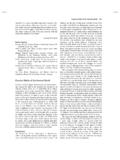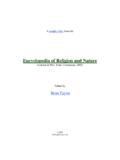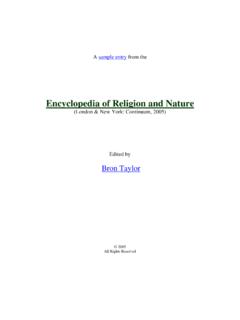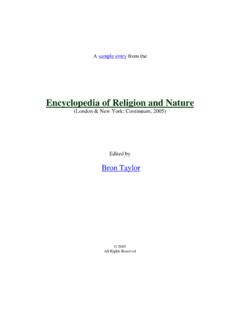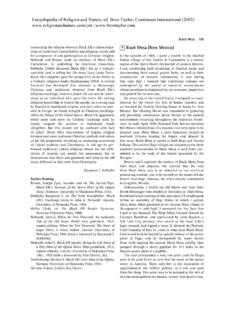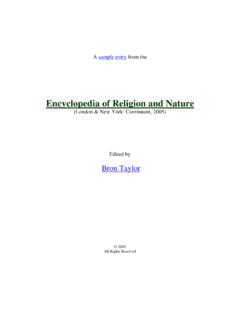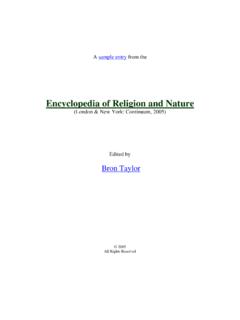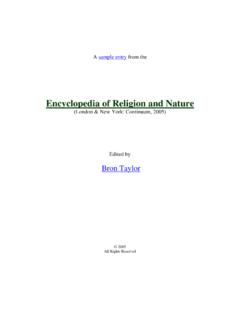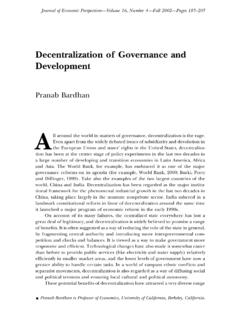Transcription of Earth First! and the Earth Liberation Front
1 The Encyclopedia of Religion and Nature Bron Taylor, Editor in Chief Continuum International, 2005. Earth first ! and the Earth Liberation Front Radical Environmentalism comprises a cluster of environmental movements and ideologies that share an overall worldview that includes a perception of the sacredness of nature. The religious and ideological beliefs of these movements, and the criticisms to which they are typically subjected, are described in detail in RADICAL ENVIRONMENTALISM. Their basic orientation can be, however, briefly characterized: Radical environmental movements trace environmental degradation to anthropocentric and hierarchical western philosophies and religions.
2 They prescribe in response lifestyle simplification, political resistance to the destructive forces, and a spiritual reconnection with nature. These responses, they believe, depend on a resacralization of human attitudes and perceptions of the natural world. By the early twenty- first century Earth first ! and the Earth Liberation Front (ELF) had become the best known of the radical environmental groups in the United States, Australia, and the United Kingdom, and they had established beachheads in scores of countries on every continent but Antarctica.
3 Earth first ! Earth first !, with its slogan no compromise in defense of mother Earth , was founded in 1980. It rapidly became known for its dramatic civil disobedience campaigns and the occasional use of sabotage in its efforts to thwart commercial incursions into biologically sensitive lands. In its first two decades it focused especially upon North America's remaining old-growth forests, evocatively labeled ancient or cathedral forests to reinforce their special importance. Dave Foreman, who left the WILDERNESS SOCIETY after he became disenchanted with the efforts of such mainstream environmental groups to arrest environmental decline, was the most charismatic leader among Earth first !
4 's co-founders (variously numbered at 4 or 5, depending on differing movement origin myths). His strategic purpose in founding the group was, firstly, to introduce and promote sabotage as well as civil disobedience as a means of environmental struggle, whenever possible increasing the costs and removing the profit from environmentally destructive practices in other words, waging economic warfare against those destroying nature;. secondly, to shame mainstream environmentalists into taking stronger stands by harshly criticizing them and exposing their compromising positions; thirdly, and ironically given the second tactic, he expected that by taking on the mantle of environmental extremism, a label often applied to mainstream groups by their adversaries, that mainstream groups might appear more reasonable by comparison, thereby increasing their influence and effectiveness.
5 As importantly, Foreman wanted to attack anthropocentric attitudes, for he viewed the root of the problem as religious in essence. Drawing on historians such as Lynn White, Perry Miller and Roderick Nash, Foreman argued, Our problem is a spiritual crisis. The Puritans brought with them a theology that saw the wilderness of North America as a haunt of Satan, with savages as his -1- disciples and wild animals as his demons all of which had to be cleared, defeated, tamed, or killed (Harpers Forum 1990: 44). So like most radical greens, Foreman blamed the advent of agriculture (following Paul Shepard and Jim Mason), and Christianity as well, for environmental decline.
6 During Earth first !'s early years, it was not difficult to find evidence of an anti-Christianity view, particularly since James Watt was the Secretary of the Interior. In 1976, before his appointment by President Ronald Reagan, Watt had founded the Mountain States Legal Foundation, which bills itself as a defender of individual liberty, property rights, and free enterprise. It is regarded by environmentalists as an anti-environmental group, one of the first and most important members of the so-called WISE USE MOVEMENT. Watt was also an evangelical Christian who minimized environmental problems and was widely if inaccurately perceived (largely due to selectively quoted congressional testimony) to believe the imminent second coming of Christ obviated the need for environmental concern.
7 Reagan, who had appointed him, told confidants that he also expected the imminent return of Christ. Like most radical greens, Foreman saw promise in pagan religions for a biocentric ethics. Indeed, the most common perception animating the movement can be labeled pagan, if this is defined as spirituality involving one or more of two perceptions: (1) the Earth itself is alive and sacred, a perception that for many could properly be labeled Pantheism (a word derived by conflating the Greek word pan meaning all and theos meaning god, signifying that all is god ).
8 And (2) that the world is filled with non-human intelligences often thought to be capable of communicating and communing with humans who are worthy of reverence. Such perceptions, sometimes labeled ANIMISM (from the Latin for soul ), involve a belief that various entities in nature have souls or spirits. Early in the publication of the Earth first ! journal, Foreman signaled his spiritual inclinations by publishing according to what has become known in contemporary Paganism as the PAGAN CALENDAR. He was significantly influenced by PAUL SHEPARD, GARY SNYDER, and STARHAWK, each of whom promoted earthen spiritualities.
9 Even more influential upon Foreman was the subtle nature spirituality of the ecologist ALDO LEOPOLD and the novelist EDWARD. ABBEY. After learning about ARNE NAESS and DEEP ECOLOGY shortly after founding Earth first !, Foreman and his comrades also immediately seized on and adopted deep ecology as Earth first !'s natural philosophy. But it was Abbey's Desert Solitaire (1968) that especially well the deep affective connections that Foreman had for nature, as it had for many other desert dwellers. In this book Abbey described mystical experiences in the desert that taught him humility and a proper spiritual perception, which for him meant biocentrism and a reverence for the land.
10 Abbey's novel The Monkeywrench Gang (1975) portrayed ecological saboteurs fighting back against an industrial civilization portrayed as totalitarian and relentlessly destructive. The book was not entirely fiction, because it was based on an ecological resistance movement that had begun in the 1950s and had been hinted at in Desert Solitaire. Indeed, Abbey's friend Jack Loeffler would later indicate that Abbey and many of his friends had been experimenting with The Anarchist Cookbook during the campaign to save BLACK MESA from Peabody Coal, and that some of these experiences, and related fantasies, were incorporated into the novel (author's interview, July 1997).
